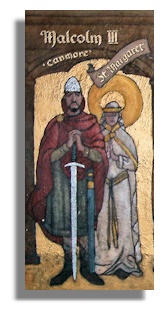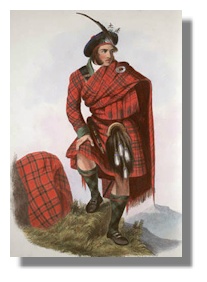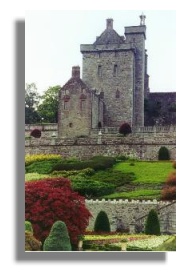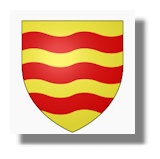Early History
Legend says that the first nobleman to settle in Drymen (a village now in Stirlingshire) was a Hungarian royal who accompanied Edgar the Aetheling, heir to the English throne, and his two sisters after they had fled to Scotland from England after the invasion by William the Conqueror in 1066. King Malcolm III (Canmore) had welcomed the fugitives and later married Margaret, one of the royal sisters (who was later to become a saint - the picture here shows Malcolm with Margaret with a halo behind her head). The Hungarian adopted the name of the parish of Drymen and this name evolved into Drummond. The family appears to have held land in the earldom of Lennox (where Drymen is located) and a later Drummond acted as chamberlain to the earl of Lennox and even married Ada, the earl's daughter around the middle of the 13th century. Later, a Gilbert de Dromund of Dumbarton rendered homage to King Edward I of England and signed the infamous Ragman Rolls along with all the main landowners of Scotland. The clan's first recorded chief to take the name was Malcolm Beg, whose third son, also called Malcolm, fought at the Battle of Bannockburn in 1314. Malcolm Drummond is credited with the deployment of caltrops, iron spikes to injure horses, before the Battle of Bannockburn. Their affect on the English cavalry made the victory possible and two caltrops are displayed as part of the Drummondís armorial bearings. After the victory at Bannockburn the king granted the Drummonds lands in Perthshire.
 The Clan Drummond gained more land in 1345 when chief John Drummond married an heiress of the Montfichets and became John Drummond of Stobhall. John's sister Margaret Drummond married David II of Scotland but they had no children. In 1357, John's daughter, Annabella Drummond married, John Stewart, Earl of Carrick and future High Steward of Scotland and King Robert III of Scotland.
The Clan Drummond gained more land in 1345 when chief John Drummond married an heiress of the Montfichets and became John Drummond of Stobhall. John's sister Margaret Drummond married David II of Scotland but they had no children. In 1357, John's daughter, Annabella Drummond married, John Stewart, Earl of Carrick and future High Steward of Scotland and King Robert III of Scotland.
Sir Malcolm, the eldest great-grandson of the previously mentioned Malcolm, obtained the clan home, Stobhall Castle, from his aunt Queen Margaret Drummond, David II of Scotland's wife.
Sir John Drummond became more powerful during the reigns of both King James III and IV and was created "Lord Drummond" in 1488, a title still borne by the present chief.
Drummond Castle
 King James IV gave the first Lord Drummond permission to build a stronghold on a rocky outcrop on the edge of Strathearn in 1490. As was often the case, the original tower keep was later modified and enlarged but the lower floors are those built by the first Lord Drummond. In 1605, King James VI (now king of England as well as Scotland), promoted James, the 4th Lord Drummond, to be the first Earl of Perth. His brother John became his successor on his death in 1611, and his sons became Earls of Perth.
King James IV gave the first Lord Drummond permission to build a stronghold on a rocky outcrop on the edge of Strathearn in 1490. As was often the case, the original tower keep was later modified and enlarged but the lower floors are those built by the first Lord Drummond. In 1605, King James VI (now king of England as well as Scotland), promoted James, the 4th Lord Drummond, to be the first Earl of Perth. His brother John became his successor on his death in 1611, and his sons became Earls of Perth.
During the Civil War, Lord Drummond led his forces in support of the Covenanters against the Royalists at the Battle of Tippermuir in 1644. The chief of Clan Drummond, the third Earl of Perth, joined James Graham, 1st Marquess of Montrose in 1645 but was taken prisoner at the Battle of Philiphaugh. He later fled to exile to France. Cromwell destroyed the keep during the Civil War but by June 1684 the 4th Earl had been appointed Lord High Chancellor of Scotland. After King James VII abdicated the 4th earl was imprisoned in Stirling castle for four years. In 1693 he was freed and joined the king in France.
During the Jacobite Uprisings, James Drummond, later to become the second Duke, supported the Jacobite cause and commanded the Jacobite cavalry at the Battle of Sheriffmuir in 1715. James Drummond, 3rd Duke of Perth was born in France but returned to Scotland in 1734 to live at Drummond Castle with his mother. He later joined Bonnie Prince Charlie in the second Jacobite Uprising when Charles Edward Stewart arrived in Perth in September 1745. At Culloden, the duke commanded the left flank but was forced to flee, dying while on the way to France. In order to avoid having government troops billeted in the keep during the '45, the Duchess of Perth had it destroyed (though it was repaired in 1822). The estates and titles were declared forfeit. In 1853, George Drummond, living in France - where he had become Duc de Melfort, Comte de Lussan and Baron de Valrose - was restored by Act of Parliament to the title of Earl of Perth and the various subsidiary titles.
See also Places to Visit - Drummond Castle and Gardens and Castle Photo Library - Drummond Castle.
 The Drummond clan motto is "Virtutem coronat honos" which means "Honour crowns virtue". "Gang warily" is incorporated in the Drummond crest.
The Drummond clan motto is "Virtutem coronat honos" which means "Honour crowns virtue". "Gang warily" is incorporated in the Drummond crest.
Surnames regarded as septs (sub-branch) of the Drummond clan include Brewer, Doig, Grewar, Gruer, MacGrowther, MacGruther.
Drummond was the 166th most frequent surname at the General Register Office of Scotland in the 1901 census.
There are is a clan Web site here.



